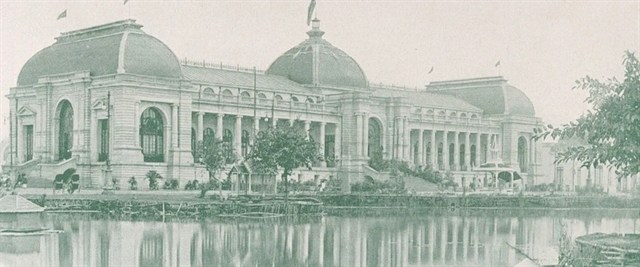 Life & Style
Life & Style

 |
| The central building of the Grand Palais in Hà Nội. — File photo of gallica.bnf.fr |
HÀ NỘI — Archival documents and images from major international and domestic trade fairs held in Hà Nội in the early 20th century will be displayed at an exhibition to be open on January 26 in the city.
The exhibition "Trade Fair Complex – Convergence of Quintessence" will showcase over 300 valuable archival documents and images of significant exhibitions and fairs that were held in the Grand Palais, an exhibition and trade fair complex in Hà Nội built for the 1902 Hanoi world trade fair. Many of them have never been displayed to the public before.
Through the exhibition, the National Archives Centre 1, its organiser, aims to introduce to the general public a rich and valuable source of archival materials about Việt Nam, while creating a space for exploring this heritage.
The Grand Palais was a magnificent and grandiose exhibition and trade fair complex, one of the most prestigious in Indochina. It was completely destroyed by American airstrikes in World War II, and only a pair of bronze lions remains, currently located at the Central Circus Theatre in Hà Nội. The complex sat at the site where the Friendship Cultural Palace stands today.
In 1902, Paul Doumer, the governor-general of Indochina, intended to organise a large-scale international trade fair in Hà Nội to showcase the industrial and agricultural products of Tonkin (North Việt Nam), along with cultural artefacts from Indochina and the Far East. Architect Adolphe Bussy was assigned the task of designing the Grand Palais Hà Nội, modelled after the original in Paris, France.
The complex, covering an area of 17 hectares on Gambetta Boulevard (now Trần Hưng Đạo Street), was inaugurated on February 26, 1902. The ceremony was attended by Governor-General Doumer, King Thành Thái, military leaders, high-ranking officials, and numerous guests from all over Indochina.
When Japan invaded Việt Nam, the complex was transformed into a military base and then destroyed completely by US bombing. Old photographs of the building were still preserved at the National Archives Centre 1, enabling the public to envision the grand structure of the past.
According to the organisers, the exhibition also provides space to showcase international trade fairs held mostly in France with the presence of Vietnamese products.
In 1866, the Huế royal court sent a delegation to the World Exposition in France. This was the first time that Chăm sculptures were introduced to the public in Europe.
At the World Exposition held in Paris in 1878, many products from Cochinchina (South Việt Nam) participated for the first time and won numerous medals.
Vietnamese products were also highly valued at exhibitions in Paris, Marseille, Lyon, San Francisco, New York, Brussels, and other foreign cities.
The exhibition will run until June 30 at the National Archives Centre 1 with free entrance. — VNS




